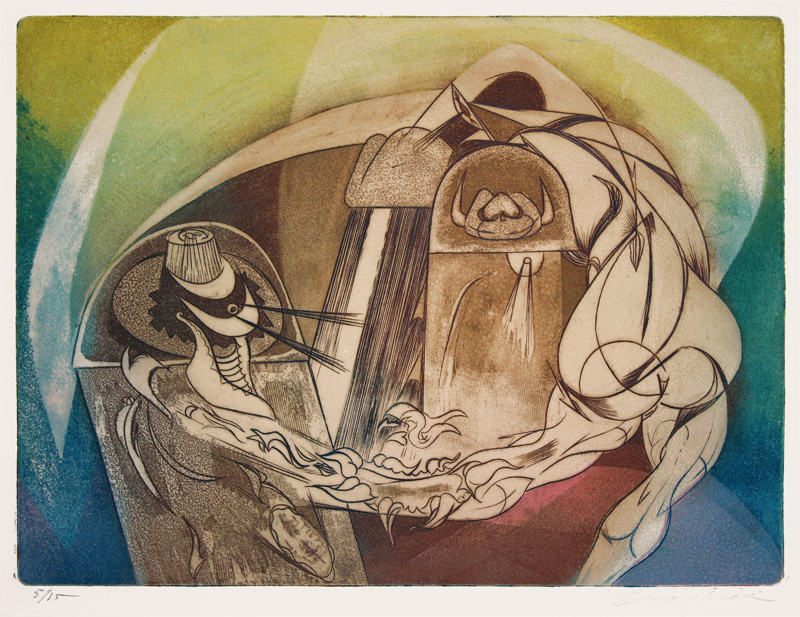Apollo and Daphne is a color etching, engraving, aquatint and softground etching created in 1956 by American artist Martin Barooshian. This impression is pencil signed and editioned 5/15 and was printed by Kaiko Moti on ivory Rives BFK paper. The reference for Apollo and Daphne is Russo 118. In his entry on this work, Russo states an edition of 18 plus approximately twenty color-variant proofs from three states. The platemark measures 10-1/8 x 13-5/8 inches.
In
Martin Barooshian: A Catalogue Raisonné of the Prints, 1948 – 1970, Russo wrote: Barooshian
advanced and adapted what he learned to suit his own abstract surrealist
interests, innovating for more precision and complexity. He further
incorporated aquatint and soft ground along with deep-bite etching in works
like Apollo and Daphne to create his own unique printmaking advances, for
which he would be recognized throughout his career.
In December 2010, Barooshian wrote: I have always been interested in pushing the limits of my subject matter, composition, color palette, and technique. My work is layered and complex. If you want simple, my art is not for you. For my entire career I have strived to capture something about the human condition. For decades I did so by creating imagined realities, abstracted figures and landscapes composed of biomorphic shapes, reveling in the poetry of the natural world and its forms. These works are immediate expressions of fleeting individual experience and large statements encompassing grand cycles of creation and annihilation. I explore the tension created as the triumph of free will still must still struggle against the inevitability of physical and cosmic processes. I pierce the veil between the sacred and the secular. My compositions incorporate pictures within pictures with windows into other states of being and experience. They are abstract and enigmatic puzzles that I invite you to explore and interpret within the context of your own life, dreams, desires, and fears.
Martin B. Barooshian, painter, printmaker, and educator, was born in Chelsea, Massachusetts on 18 December 1929. His parents were Armenian immigrants who survived the Armenian Genocide of 1915. Their history, combined with the knowledge of his deceased uncle Mihran's own artistic ambition, remained influential to Barooshian throughout his career.
Barooshian was awarded a full scholarship to the School of the Museum of Fine Arts Boston [SMFA], and through a joint program with Tufts University, he earned a four-year undergraduate diploma in Studio Arts with highest honors in 1952. Two years later, in 1954, he received his Bachelor of Science in Education degree and, in 1955, he earned his fifth-year graduate certificate from SMFA. Barooshian continued his education at Boston University and received his Master of Arts in Art History degree in 1958 with highest honors.
Though often considered primarily a painter, Barooshian learned the basics of printmaking under the guidance of Ture Bengtz at the SMFA. In post-war Paris, he studied intaglio processes at Stanley William Hayter’s Atelier 17 and lithography at the ateliers of Gaston Dorfinant and Jean Pons. His work is influenced by the Surrealists, as well as Paul Gauguin, William Blake, and Arshile Gorky. In 1954, he was represented in the exhibition Young American Printmakers at the Museum of Modern Art, New York.
During his thirty-five-year career, Barooshian taught at the School of the Museum of Fine Arts Boston, the Pratt Institute, and the Rhode Island School of Design, as well as in the public school systems in Somerville and Chelsea, Massachusetts.
Barooshian was a member of the Print club of Albany, the American Color Print Society, the Armenian Artists Association of America, the Boston Printmakers, the Long Island Printmakers Society, and the Society of American Graphic Artists (SAGA) and served as president for this organization from 1972 to 1974. For a time, he was also president of the U.S. Committee of the International Association of Art for UNESCO. In addition to teaching and membership activities, Barooshian was a collector, curator, and dealer, and is credited with encouraging once-pioneering artists to revive their stalled careers, among them Armin Landeck, Doel Reed, and Gerald Geerlings. In 1977, he co-curated with Louis Freedenberg the Pratt Institute’s traveling exhibition Forerunners of the American Print Renaissance 1920–1950. In 1997, Barooshian was awarded the Dorothy Lathrop Award for Outstanding Service by the Print Club of Albany.
Barooshian's work was been in included in numerous group exhibitions and had at least fifty solo exhibitions. A retrospective exhibition of his work was mounted in May 2006 at the Armenian Library and Museum of America in Watertown, Massachusetts. His work is represented in the collections of the Addison Gallery of American Art, Andover, Massachusetts; the Museum of Fine Arts Boston, Massachusetts; the Brooklyn Museum, New York; the Indianapolis Museum, Indiana; the National Gallery of Modern Art, New Delhi, India; the Metropolitan Museum of Art, the Museum of Modern Art, and the New York Public Library, New York; the Portland Museum of Art, Oregon; the Montreal Museum of Fine Art, Quebec, Canada; the Library of Congress and the National Gallery of Art, Washington, D.C.; and the Armenian Museum of American, Watertown, Massachusetts.
Martin Barooshian died at his home in North Reading, Massachusetts on 25 January 2022.



